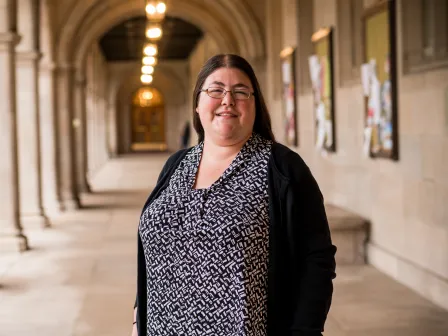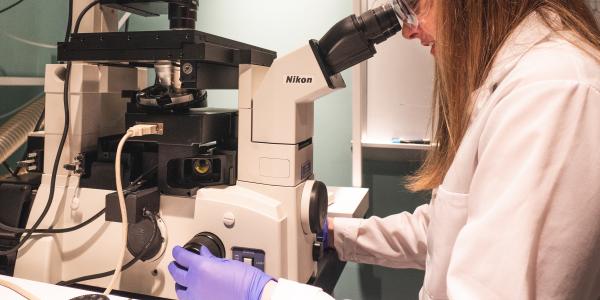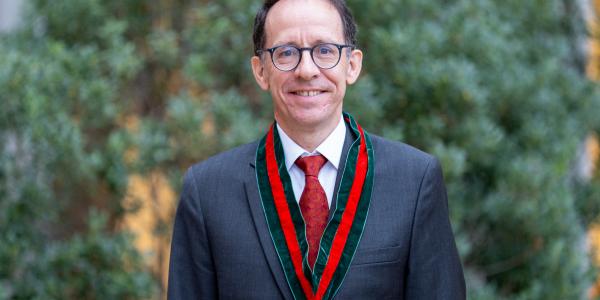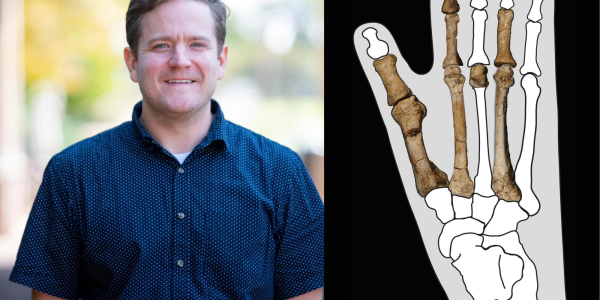Using advanced biophysical and imaging techniques, Meredith Jackrel and her team have isolated Matrin-3 to better understand its role in neurodegenerative diseases.

Using advanced techniques in biophysical chemistry, a team led by Meredith Jackrel, an associate professor of chemistry, has achieved unprecedented views of a protein that may play a pivotal role in some cases of amyotrophic lateral sclerosis (ALS) and the related disorder frontotemporal dementia (FTD). Their work could open doors to new approaches for treatment and prevention.
Jackrel and her team described the advance in the journal Molecular Cell. Macy Sprunger, PhD ’23, a staff scientist in the Department of Chemistry and former graduate student in Jackrel’s lab, is the study’s lead author. Other co-authors include chemistry graduate student Sabrina Talir; former undergraduate Ken Lee, AB ’24; Min Kyung Shinn, a postdoctoral researcher at the McKelvey School of Engineering; and Rohit Pappu, the Gene K. Beare Distinguished Professor of biomedical engineering.
The work was supported in part by the nearly $430,000 National Institutes of Health (NIH) grant Jackrel was awarded in 2023, as well as funds from the ALS Association and Target ALS.
Jackrel and her team focused on Matrin-3, a little-studied protein with potentially broad health implications. Normally, the protein helps regulate nucleic acids, cell survival, differentiation, and gene expression. Mutations in Matrin-3 can cause it to misfold, taking on abnormal functions.
Over time, misfolded proteins can disrupt nerve function and contribute to neurodegenerative diseases such as ALS, also known as Lou Gehrig’s disease, and FTD, a type of dementia caused by damage to the neurons in the brain’s frontal and temporal lobes.
To better understand the disease process and explore potential treatments, Jackrel and her team aimed to produce a clear picture of Matrin-3 — a challenge that took years to overcome.
One major hurdle was finding a way to chemically separate the protein from the rest of the cell. After much trial and error, Sprunger was able to isolate pure samples of Matrin-3. “Purifying Matrin-3 was a very formative portion of my graduate studies,” Sprunger said. “I knew it was going to be challenging, and I ended up spending over two years troubleshooting this process. I was about ready to give up when we finally found an approach that worked.”
The team then used advanced electron microscopy to characterize the shapes of the protein assemblies. “We found tiny spheres that seemed to transform naturally into worm-like shapes,” Jackrel said. “We’ve never seen these types of shapes before, so that was our first hint that something unusual was happening.”
Collaborating with Pappu and Shinn through the Center for Biomolecular Condensates, the team determined that the transition from spheres to worms likely occurs through a process called microphase separation.
When non-mutated Matrin-3 protein was mixed with RNA, the worm-like assemblies significantly shortened. “Matrin-3 is an RNA-binding protein, so it was important for us to study that interaction,” Jackrel said.
Mutated versions of the protein found in disease also formed spheres and worms, but their length remained largely unchanged when exposed to RNA. “The mutations associated with ALS seem to be making these worm-shaped proteins more resistant to change,” Jackrel said. “This may be a part of the disease process.”

With a reliable method to purify Matrin-3, as well as new ways to image the protein in living cells, Jackrel’s lab plans to continue experiments to better understand the protein’s role in health and disease. It is also likely that microphase separation is a widespread phenomenon that has not been well-studied due to the very small size of these assemblies, and so they are also studying this idea more broadly.
“Macy’s work to purify the protein and figure out how to experimentally study these extremely small assemblies was a major advance for our lab and for studying the root causes of ALS,” Jackrel said. “We’re excited to take the next steps.”
Header image: Meredith Jackrel’s lab (Credit: Sean Garcia)





